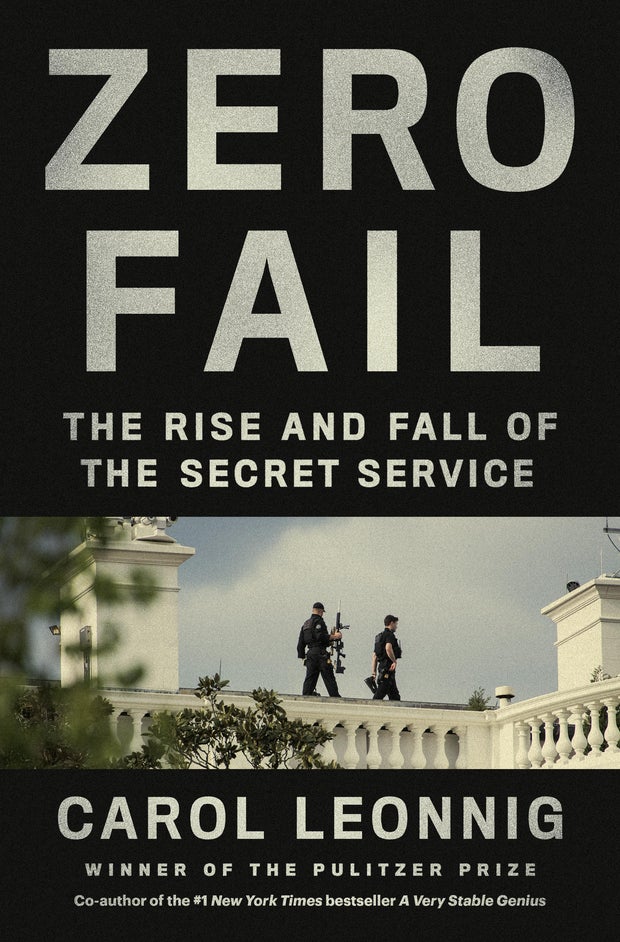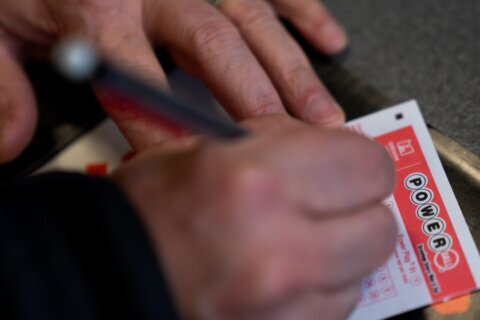In her new book, “Zero Fail: The Rise and Fall of the Secret Service” (Random House), Pulitzer Prize-winning Washington Post reporter Carol Leonnig (co-author of the bestselling “A Very Stable Genius: Donald J. Trump’s Testing of America”) traces the evolution of the agency responsible for protecting the president, and how in recent years the Secret Service has become marred by black marks, scandals, and a toxic work culture.
Read the excerpt below, and don’t miss Jim Axelrod’s interview with Carol Leonnig on “CBS Sunday Morning” May 16!

Random House
Chapter 1
Protecting Lancer
Win Lawson felt his chest puff out a little this particular day in Buffalo, his shoulders hiking his lanky frame just a little taller and straighter. Proud. Yep, he could admit it to himself. Win Lawson, the shy, quiet worrier, felt proud.
The thirty-four-year-old had grown up in a no-stoplight town along the banks of Lake Erie that few outside upstate New York had ever heard of: Portland, New York. The community, about sixty miles south of Buffalo, was best known for its chilly lake air, vineyards and apple farms, and families as hardy as the crops they tended.
Lawson, the son of an elementary school teacher and a local banker, had left for college the summer after high school. He got his degree, married a fraternity brother’s sister, and joined an Army intelligence unit as the Korean War began.
Now, a dozen years later, on this fall day in 1962, Lawson had returned to his home turf in a prestigious new role: He was an agent with the Secret Service, assigned to protect the president of the United States.
Nearly two hundred thousand people spilled across Buffalo’s largest downtown square, angling for a glimpse of the most famous man on earth, John Fitzgerald Kennedy. And Win Lawson stood beside him.
Kennedy visited Buffalo on October 14, 1962, the day of the city’s beloved Polish heritage parade. Seeing the crowds eight deep on the limo route, Lawson thought: Polish or not, all of upstate New York has turned out today to see their dashing president.
Lawson and the seven other members of the president’s detail had a job that required every ounce of their concentration: Safeguard Kennedy from start to finish of the trip. They shadowed him as he stepped off Air Force One, as he stood waving from his limo the last half mile of the parade, and now finally as he addressed the enormous crowd in the city’s center — Niagara Square.
That inner ring of detail agents kept a unique vigil that relied largely on sensory instinct and coiled muscles. When “the Boss” — their informal name for the president — stepped on the platform stage, his detail trained their eyes and ears on the crowd for any odd duck, strange movement, or person with hands stuffed in their pockets. When Kennedy was shaking hands, as he loved to do, detail agents flanked him on either side, watching those outstretched hands for any sign of danger. Their duty: to put their body between the president and a gun, knife, or any other threat.
Standing at the base of the wooden stage in front of City Hall, Lawson rotated his head from left to right, scanning the square, a human periscope rolling over endless heads, faces, and arms, alert to any sign of danger.
For this visit, Lawson had the added duty of serving as the Secret Service’s chief of security planning. He had arrived three days earlier to assess the safety of every step the president would take on the visit, an elaborate choreography known as “the advance.” He had chosen which streets to block off for the motorcade, how close crowds could stand, and what perimeter posts local cops and motorcycle escorts would man.
But Lawson’s meticulous planning didn’t change the laws of physics: He and his fellow agents were ultimately insignificant dots in the swirling mass of people pouring into the square.
Cheers went up as Kennedy told the crowd they had kept Poland in their hearts and urged them to pray that her people might one day live free of Communist rule. “And as the old song says, ‘As long as you live, Poland lives,'” Kennedy continued. Thundering applause filled the square. Kennedy smiled at how long he had to wait before he could say the next line.
Kennedy was winning hearts, and — his political aides hoped — votes. To help Democrats win congressional seats that November, the White House wanted as many voters as possible to see the president. Secret Service agents privately disapproved of how close Kennedy wanted to get to his public, but they didn’t have the power to override him. Still, the agents knew that the longer the parade route and the more hand-shaking at rope lines, the greater the chances that something bad could happen.
Hard as it was to believe that the president needed protecting from the cheering masses in Niagara Square, Lawson and the detail had to assume at all times that an enemy lurked within the throng. Kennedy may have been handsome, rich, and devilishly charming, but plenty of people in the country despised him. A select few wanted him dead.
The forty-three-year-old politician threatened the status quo. He was the first Catholic to win the presidency, a shock for an older generation that considered Protestants the nation’s nobility. Many Americans were also deeply unsettled by Kennedy’s insistence that Blacks deserved to study in the same schools, use the same bathrooms, and eat in the same restaurants as Whites.
A few weeks after Kennedy won the 1960 election, Richard Pavlick, a retired seventy-three-year-old postal worker with a history of mental problem and rants against Catholics, loaded the trunk of his Buick with seven sticks of dynamite. He drove from his native New Hampshire to Palm Beach, where the president-elect was staying before his inauguration. Pavlick plotted to blow up Kennedy by ramming his car as he left to attend mass, but he scrapped the plan when he saw Kennedy’s wife and children walking by his side. Palm Beach police arrested him a few days later, based on a tip from a worried colleague who pieced together that Pavlick had been stalking Kennedy.
In Kennedy’s first six weeks as president, the White House received three times the average number of letters threatening violence against the president. “We are sick of the dirty black Catholics,” read one anonymous letter postmarked from Los Angeles. “The next bomb will be for you, Mr. Kennedy.”
The agents who make up the president’s White House detail privately feared for Kennedy’s safety. And not just because their job naturally bred paranoia. To the public, President Kennedy was a dashing, cerebral leader with a picture-perfect family. In private, Kennedy’s Secret Service agents saw a man courting danger.
Kennedy kept up an unrelenting pace compared to his predecessors, and it pushed his detail close to exhaustion. He was also extremely reckless with his own personal safety. His actions made some of his protectors uneasy and a few quite angry. The agents on his detail liked the new president personally, but professionally, he was their toughest assignment yet.
When Kennedy moved his young family into the White House in January 1961, the Service was so small it resembled a modest city police force more than a federal agency. The Service’s top official was even called Chief. The agency ran on a $5 million budget and employed just over three hundred agents, the majority of whom were stationed in field offices spread across fifty states. Just thirty-four agents were assigned to the White House detail — the arm that protected the president. They typically worked in six-man teams around the president, rotating in eight-hour shifts.
These agents — all men, and most of them from working-class backgrounds — had grown up in the shadow of World War II and possessed a keen sense of duty to country. The typical hire was an athletic, straitlaced college graduate in his late twenties or early thirties who served in the military or worked for a local police department.
New agents were always sent first to a field office, but “keepers” were summoned to the White House for a tryout on the detail within one or two years. The Service struck a deal with the federal government to bypass the federal hiring pool and instead hire any agent the chief wanted. As part of the agreement, the Secret Service had to put these relatively junior agents on the president’s detail within two years if the Service wanted to keep them on the job.
The agents received no specialized protection training, but learned on the job from experienced colleagues on the detail. “That’s how the Secret Service worked. They got you started, they paired you with someone good,” said Tim McIntyre, a former Kennedy detail agent. “The Service had a policy of allocating assignments to you and expecting you to respond. When you’re posted at various spots, it could be anyplace. It could be in an auditorium. They don’t have time to spend to explain a whole lot to you. They expect you to pick up the ball and run with it.”
The work of an agent, standing watch at a fixed post, was grueling — even boring. But working alongside the affable, debonair Kennedy gave the job a special cachet. And unlike the general before him, this president made an effort to get to know his agents and greeted them by name. His glamorous life, which included regular sightings of Frank Sinatra, Marilyn Monroe, and the queen of England, sprinkled a little stardust on his security team. Agents relished standing next to history.
“I’d go down to the LBJ ranch, I’d be working the midnight shift. I’d be standing under one of those big oak trees out in front. And it’d be two in the morning, and it’d be cold,” Lawson grimaced, recalling one assignment. “You’d think, ‘What in the world am I doing here? You know I’m a college graduate and here I am almost like on guard duty in the middle of the night and so far away. I’ve been away from home, it’s over Christmas,’ whatever.
“Then maybe two weeks later, you’d go to an event you couldn’t buy your way into. I was at Cape Canaveral … for the first moonshot. I was there when they took off,” he said. “You think, ‘My gosh, I’m a guy from a little town in western New York and look what I’ve just been witness to.'”
The Polish heritage parade was one of those days for Lawson. After the parade was over, the president of the United States hopped into his open-topped limousine and left Buffalo, all without incident. Then, as he’d prearranged, Lawson met his parents and brother at the Niagara Falls airstrip parking lot and quickly placed them in a choice spot on the fence line. He knew the president would shake hands there before boarding his plane for the return flight to Washington. Kennedy loved this part of his public outings best: the face-to- face greetings with voters who’d waited for hours to welcome him.
As the president neared Lawson’s family, Lawson stood behind his left shoulder and nodded quickly at his parents. Lawson’s shift leader, Floyd Boring, paused at their section of fence.
“Mr. President,” Boring said, “this is Agent Lawson’s family.”
Ever gracious, the president beamed. He shook hands with Lawson’s brother and father and thanked them for Win’s service. Lawson’s mother, wearing one of her best day dresses and a pillbox hat decorated with pink and lavender flowers, thrust her right hand toward him with a determined look.
“I am sorry for how busy we have been keeping your son,” Kennedy said, grasping the mother’s pale white arm. And then came that Kennedy trademark: his whip-fast humor. “He must be doing a pretty good job, because nobody has shot me yet,” the president deadpanned.
From the book “Zero Fail: The Rise and Fall of the Secret Service” by Carol Leonnig. Copyright © 2021 by Carol Leonnig. Published by permission of Random House, an imprint and division of Penguin Random House LLC. All Rights Reserved.
For more info:
- “Zero Fail: The Rise and Fall of the Secret Service” by Carol Leonnig (Random House), in Hardcover, Large Print Trade Paperback, eBook and Audio formats, available May 18 via Amazon and Indiebound







